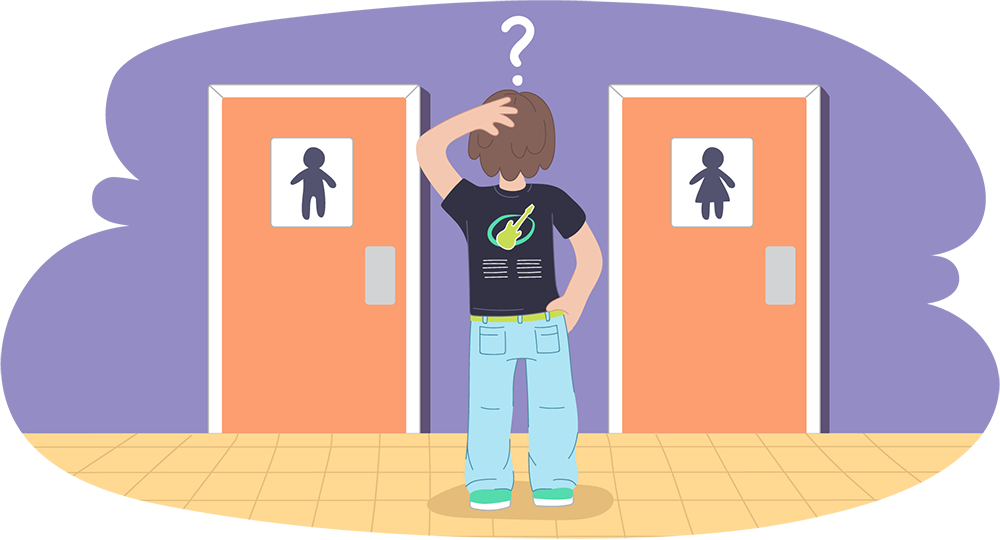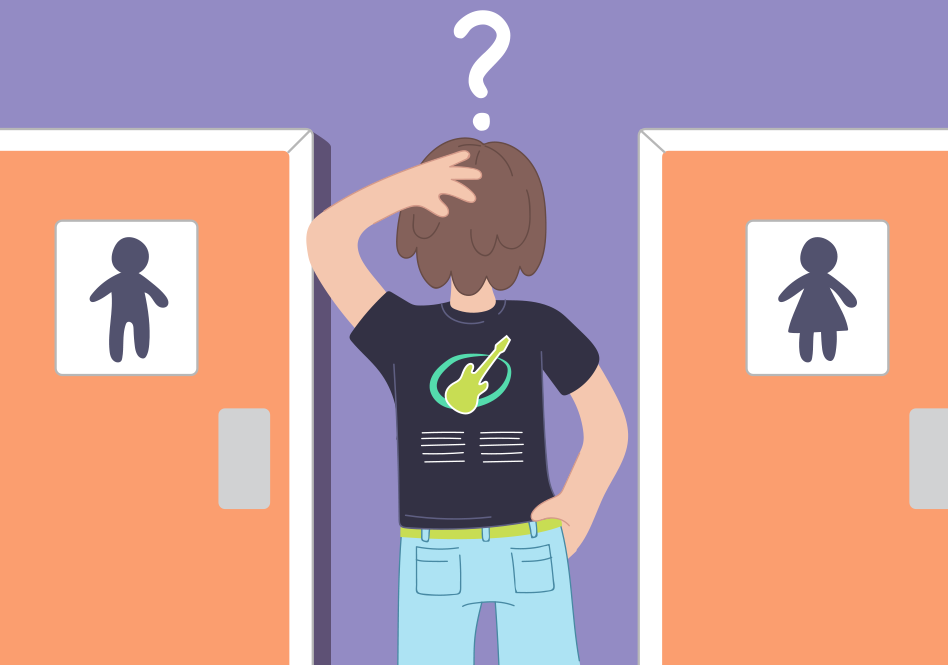Gender Identity
There’s more to gender identity than being male or female. Learn more about gender identity and the different ways people can identify themselves.

This article was written and reviewed by people in the LGBTIQA+ communities.
What is Gender Identity?
Gender identity means how you experience your own gender. It may seem simple, but it is a lot more complex than you might think!
- Sex can mean lots of different things. It can be about biological features our bodies have, like our genitals and chromosomes. It can be the assigned sex a doctor gives us at birth, depending on what our genitals and chromosomes look like. It can also be a legal status that we’re given at birth or that we change over our lives. We usually assume a person’s assigned sex decides their gender, but it’s more complex than that!
- Most societies think there are only two genders that people identify with, either male or female. This belief is called the gender binary.
- Most societies also have expectations and stereotypes about gender based on someone’s assigned sex. Like expecting males to be “tough” and females to be “gentle”. These gender expectations can affect a person’s social, work and legal rights.
- From a young age, most children know what their gender identity is and find it really hard to think about themselves in another way. People who don’t fit the gender binary, but feel pressure to follow it, can experience an extreme form of distress called gender dysphoria.
- But gender identity is about how you experience your own gender, despite what society expects. Your gender can be shown through your identity (eg. labels, pronouns), body (eg. appearance) and expression (eg. how you act, how you dress).
- Feeling able to show your true gender identity is important to your emotional and mental health.
- There are lots of possible gender identities out there! People can identify as one of the binary genders, as moving between genders, as no gender or as another gender altogether.
What is the difference between Gender Identity and Sexual Identity?
Gender identity and sexual identity are often confused, but it’s important to understand how they are different.
Gender identity is about how we see ourselves in terms of gender. Whereas sexuality is about who we’re emotionally, physically and romantically attracted to.
Confusion about gender identity and sexuality can also make it harder for people to understand themselves. Like trans or gender diverse people who think they must be gay, lesbian or bisexual - until better understanding their gender identity.
Confusing gender identity and sexuality can lead to people making the wrong assumptions about others, which affects how well we understand and communicate with them.
Trans and gender diverse people may at any given time change their sexuality to be affirming of their gender identity. Like a straight male who transitions to female and continues to want sexual and emotional relationships with women might redefine their sexuality as lesbian.
For example, when someone’s gender expression is different to what people expect, they are often assumed to be gay or lesbian. Like boys who take Home Economics at school or girls who play Rugby for sport.
Bodies are different to both gender identity and sexuality. Our identities are informed by our bodies and the experiences we have, but our bodies don’t define everything about us.
I’m questioning my gender identity. Is it normal to feel…?
Understanding yourself takes time, so it’s normal for some people to feel unsure about their gender identity. But keep in mind:
- It’s not “just a phase” and you’re not “just confused”. From a young age, children generally know their gender identity and find it really hard to think of themselves in any other way.
- Even if you start feeling comfortable expressing your gender identity, people may try to fit you into boxes. But remember, gender is about much more than the gender binary.
- Gender identity isn’t set in stone. Understanding yourself takes time and it’s normal to change your mind many times about how you define and express your gender identity before things ‘feel right’ for you.
Realising that your gender identity doesn’t fit the roles, expectations and stereotypes people have of your assigned sex and gender can be confusing and upsetting. As a result, you may feel pressured or scared about expressing your gender identity.
People who feel pressured or scared to express their gender identity may choose to conceal this to feel safer. Unfortunately, this can sometimes be upsetting too. Even if you express your gender identity openly, you might face challenges like: stress about “not fitting in”, feeling invalidated when your gender doesn’t fit stereotypes or discrimination.
In both cases, when people don’t feel free to express their gender identity it can increase their gender dysphoria and increase the risk of mental and physical health problems.
On the positive side, feeling able to express your gender identity around supportive people who accept you for who you are can feel validating and freeing!
"I know that I can live as me."
What can I DO to help me feel more comfortable expressing my gender identity?
If you want to start expressing your gender identity, but are unsure what steps you can take, here are a few ideas that may help:
Check these out too:
Sexual Identity
Relationships come in many forms. Learn more about sexuality and the different ...
READ MESexual, gender and bodily diversity discrimination
Many LGBTIQ+ people experience discrimination that can affect their lives. Learn more ...
READ MEExpressing your feelings
Expressing how you feel can help you cope when life throws you ...
READ MEHow to ask for help
Sometimes we need help but we're not able to ask for it. ...
READ METalking helps! We’re here for you.
No problem is too big or too small.
We're here 24 hours a day, 7 days a week






